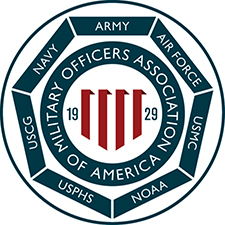MOAA IN ACTION: MAJOR LEGISLATIVE ACCOMPLISHMENTS
(Updated October 18)
MOAA engages with Congress on all manner of issues related to the uniformed services community. These efforts can include collaboration with other like-minded organizations and with The Military Coalition. We also rely heavily on our members who make their voices heard by contacting lawmakers via MOAA’s Legislative Action Center, by participating in our annual signature advocacy event, and through local efforts at the chapter and council level.
For more than 90 years, this work has led to real results – pay and benefits protected from budget-driven threats, continued access to quality medical care, and countless other areas of concern to our members, our military, and the wider uniformed services community.
No list could encompass everything MOAA’s achieved since 1929, but below, you’ll find some of the highlights, broken into six categories. Click the links for details on each of the items (or scroll below the boxes to see the full list), and reach out to MOAA’s legislative team at legis@moaa.org to discuss your concerns on these or other topics.
Active Duty
Executing a Credible Game Plan for Health Care Oversight
As part of the FY 2017 NDAA military health system (MHS) reform legislation, Congress directed DoD to restructure the direct care system of military hospitals and clinics to improve focus on military medical readiness. This led to a February 2020 DoD report to Congress outlining plans to downsize dozens of military treatment facilities (MTFs). It came on the heels of a separate proposal in the DoD budget request to cut 18,000 medical staff to realign resources in support of the National Defense Strategy.
With hundreds of thousands of beneficiaries potentially affected by these changes, MOAA immediately pressed DoD officials for the statistics and analysis behind these moves, and asked Congress to exercise its oversight authority and ensure continued access to quality care. Media outlets amplified MOAA’s messages of concern.
These messages grew louder as both the military and civilian medical systems began buckling under the strain of COVID-19. MOAA led the charge to ensure continued access to quality care as MHS reforms are implmented. With the FY 2020, 2021 and 2022 NDAA laws, MOAA has achieved three consecutive halts to planned medical billet cuts along with enhanced congressional oversight to MHS reforms, including:
- A DoD report to Congress on analysis, metrics, and mitigation planning related to proposed billet cuts – Section 719, FY 2020 NDAA.
- A DoD review of the medical manpower requirements for all national defense strategy scenarios, including with respect to the homeland defense mission and pandemic influenza – Section 717 – FY 2021 NDAA.
- A DoD requirement to certify to the congressional defense committees that beneficiaries impacted by MTF restructuring will have access to civilian care through the TRICARE program – Section 718 – FY 2021 NDAA.
- A GAO evaluation of the DoD analyses used to support any reduction or realignment of military medical manning and a compliance report that requires DoD to explain any reductions in MTF staffing – Section 731 – FY 2022 NDAA.
This issue also impacts Families, Retirees, and Survivors.
Maintaining Pay Raise Comparability
A quick look at this list and others like it show the wide range in year-over-year pay raises among the military community. MOAA has fought to ensure those who serve get what they’ve earned, and has been part of efforts in recent years to secure the largest raise in a decade.
This work hasn’t always broken records, but it’s proceeded, largely with success, toward a goal of pairing raises with the Employment Cost Index (ECI), a metric that, by statute, links military pay increases with civilian economic indicators. The basic pay raise has not dipped below ECI since FY 2016.
This work not only benefits the current force but helps increase the base pay for future military retirees, which will lead to greater benefits after service.
Families
Securing Comprehensive Privatized Military Housing Reform*
MOAA helped bring to light a series of health-threatening problems faced by military families in privatized housing, ranging from mold to rodent infestation to unanswered repair requests.
With pressure from MOAA and other advocacy agencies, Congress and DoD officials eventually acknowledged these unsafe, unsanitary conditions. The FY 2020 NDAA included a number of provisions to improve the day-to-day lives of military families, part of the most sweeping military housing reform in a quarter-century:
- A “Tenant Bill of Rights” informing military families of their ability to lodge complaints, withhold rent during disputes, and secure the maintenance history of their unit.
- A more transparent process on work orders requiring tenants to sign off before the orders can be closed, as well as the creation of a public complaint database.
- Requirements making it easier to hold landlords accountable for medical costs incurred by tenants and by DoD related to unsafe or unsanitary housing conditions.
- A long-sought formalized dispute resolution process that offers clear roles for tenants, landlords, and the installation commander.
MOAA’s work on this issue continues, as do efforts to urge Congress to include protections and oversight of government-owned housing and barracks in these reforms.
Securing a Basic Needs Allowance for Families Facing Food Insecurity
MOAA, working with organizations including MAZON: A Jewish Response to Hunger and the National Military Family Association, highlighted the number of military families facing food insecurity. Together, we advocated for the creation of a Basic Needs Allowance (BNA), a monthly payment to servicemembers whose gross household income falls below 130% of federal poverty guidelines for the member’s location and household size. Of note, the proposed legislation we advocated for excluded the basic allowance for housing (BAH) in the calculation of gross household income.
Several factors played into the rise of food insecurity among military families:
- The 2.6% pay gap that has resulted from multiple years of the military basic pay raise not meeting the Employment Cost Index (ECI).
- A decades-long 22% or higher unemployment rate among military spouses – likely more in the 30% to 34% range following impacts of the pandemic on women in the workplace.
- High rates of ineligibility for Supplemental Nutrition Assistance Program (SNAP) benefits for military families due to the inclusion of the housing allowance in the calculation of gross household income.
- Skyrocketing housing rates nationwide.
After a successful virtual Advocacy in Action event in 2021, language was included in the FY 2022 NDAA directing DoD to create the Basic Needs Allowance; however, the inclusion of BAH in the calculation of gross household income is at the discretion of service secretaries, leaving MOAA and other advocacy organizations unsure how well the BNA will address food insecurity.
Temporary BAH Increase for High Cost-of-Living Areas
With real estate and rental markets skyrocketing in the wake of the pandemic, MOAA and other advocacy organizations spoke with DoD officials urging them to address the failure of the basic allowance for housing to keep pace. In response to our efforts, DoD identified 56 geographic areas as having rising rents and an inadequate supply of rental housing. Servicemembers in these areas (estimated at more than 200,000) were granted eligibility for a 10% to 20% boost in their housing allowance, depending on location.
MOAA continues to track this issue, focusing on forward-thinking solutions that will allow DoD to more quickly and effectively address changes in the housing market.
Enhanced Leave for Military Families
The amount of paid parental leave varies between services. In the FY 2022 NDAA, Congress addressed those inequities with the goal of standardizing paid parental leave across the branches of service and providing equity with plans offered by civilian employers.
The FY 2022 NDAA provides a total of 12 weeks of paid parental leave during the year following the birth or adoption of a child, or the placement of a child for long-term foster care. This leave is offered to primary caregivers, in conjunction with six weeks of maternity leave for those who give birth, as well as to secondary caregivers.
A new category of bereavement leave is also included in the FY 2022 NDAA, providing up to two weeks of leave in the event of the loss of an immediate family member.
Support for Public Schools Serving Military-Connected Children
The FY 2022 NDAA authorized $50 million for local school districts with large numbers of military-connected students and an additional $10 million for schools serving military children with special needs. This important funding ensures military kids in public schools receive the high-quality education they need and deserve.
Guard & Reserve
Securing Major GI Bill Upgrades to Include Transferability and Improving Benefits for Those on Title 32 Orders*
MOAA and other advocacy groups secured a major victory for servicemembers and military families with the passage of the Post-9/11 Veterans Educational Assistance Act of 2008, better known as the Post-9/11 GI Bill. Among other benefit improvements, the legislation:
- Ensured full state college tuition for post-9/11 servicemembers.
- Improved housing, book, and fee stipends.
- Allowed transferability of benefits to spouses and children, after the servicemember cleared certain time-in-service thresholds.
In 2010, MOAA backed improvements to the bill that included coverage of job training courses, access to benefits for National Guard members on Title 32 orders, and the expansion of transferability to members of the commissioned corps of the U.S. Public Health Service and the National Oceanic and Atmospheric Administration.
More recently, MOAA joined dozens of advocacy groups fighting on behalf of students and veterans to secure passage of legislation protecting these benefits during the coronavirus pandemic.
Improving Guard and Reserve TRICARE Coverage (and Securing a Premium Cut)
Despite the critical role played by those who serve in the National Guard and Reserve, these military members can be overlooked or treated unfairly when it comes to ensuring their access to earned benefits. Health care may be the clearest example of this; MOAA has worked for years to help these servicemembers get the benefits they deserve, and to do so without exorbitant cost shares.
Some examples:
- MOAA supported language in the FY 2009 NDAA, passed in 2008, that required DoD to recalculate TRICARE Reserve Select premiums. The result: Monthly premiums dropped by 44% for individuals and 29% for families in 2009.
- In 2004, MOAA backed legislation that permanently authorized a pre- and post-call-up TRICARE coverage period for members of the reserve component.
- In 2019, MOAA joined its partners at The Military Coalition in supporting the expansion of TRICARE Reserve Select to federal employees. A provision in the FY 2020 NDAA secured this expansion as of 2030, but MOAA and the coalition will continue efforts to make the benefit available before that date.
Ensuring Guard and Reserve Retirement Age Credit for Active Duty Service
MOAA supports a comprehensive reserve retirement policy based on an age-and-service – including operational service – formula. For this reason, MOAA backed language in the FY 2008 NDAA that reduced the age Ready Reserve members could draw retired pay (normally age 60) by three months for every aggregate 90 days of active duty performed in a fiscal year after Jan. 27, 2008.
Seven years later, the FY 2015 NDAA allowed those 90 days to stretch over two consecutive fiscal years.
Retirees
Protecting TRICARE For Life*
The TRICARE For Life (TFL) program launched in 2001. Since then, TFL has come under budgetary attack in multiple legislative cycles, with MOAA and other advocacy groups working to preserve the benefit for Medicare-eligible uniformed services retirees and their families.
MOAA’s advocacy efforts, including congressional testimony, statements for the record, and engagement with Armed Services Committee staff and member offices on Capitol Hill, successfully blocked five consecutive administration budget request proposals for a TFL enrollment fee in fiscal years 2013-2017.
These proposals included enrollment fees based on military retirement income level that would have been indexed annually based on either retiree COLA or health care inflation.
Lessening the Impact of TRICARE Fee Hikes
MOAA has long fought legislation that would burden TRICARE beneficiaries with additional costs as a way to address budget shortfalls in other areas. As Congress considered potential military health system reforms, MOAA was instrumental in:
- Blocking the Military Compensation and Retirement Modernization Commission health care proposal to eliminate TRICARE and replace it with a selection of commercial health plans including monthly premiums and significantly higher out-of-pocket costs for working-age retirees.
- Grandfathering servicemembers and retirees who entered service before Jan. 1, 2018, from TRICARE retiree enrollment fee increases ($450 individual/$900 family for Select) and a new non-network deductible ($300 individual/$600 family) imposed on new entrants.
- Fighting multiple attempts to eliminate grandfathering (included in FY 2018 administration budget proposal and provisions in the Senate versions of the FY 2018 and 2019 NDAAs) which would have resulted in higher out-of-pocket costs for Group A/grandfathered retirees.
Defeating ‘COLA Minus 1 Percent’*
Language passed in a late-2013 continuing resolution would have cut any cost-of-living (COLA) adjustment for military retirees by 1 percent, costing an E-7 retiring after 20 years $83,000 before age 62 and an O-5 retiring after 20 years $124,000 over the same span. Any increase of less than a percent would mean no raise for these retirees, though the law prohibited any negative adjustment.
Despite opposition of the proposal by many lawmakers, the provision became law the day after Christmas. MOAA and some other members of The Military Coalition – a coalition of dozens of groups representing millions of servicemembers, retirees, their families, and survivors – testified to Congress on the harm this measure would do to military retirees.
Some of those figures, including MOAA’s example of a typical enlisted retiree losing $83,000 after 20 years of service, were cited in lawmakers’ efforts to rescind the measure.
This work on the Hill, alongside the phone calls, letters, and visits from MOAA members and The Military Coalition, led to the inclusion of repeal language in a separate bill, speeding the process to ensure rapid passage. The bill rescinding this attempt to reduce military retired pay became law Feb. 15, 2014, averting financial disaster for existing retirees and those to come who entered uniformed services prior to Jan. 1, 2014.
Unfortunately, COLA will likely be targeted again to pay for programs outside of the personnel accounts. Back in 2010, a commission appointed by the President noted a $17 billion yield for DoD if it were to eliminate COLA increases during what are considered working-age years (up to 62). The cost of the repeal MOAA helped secure in 2014 carried an estimated cost to DoD of $6.8 billion over 10 years. Read more about this at this link and stay connected on this important aspect of military retired pay.
Boosting Compensation Significantly for Retirees With 50% VA Disability (and Fighting for Full Concurrent Receipt)*
MOAA has been fighting for concurrent receipt, the ability to receive both retired pay and VA compensation in full each month, since the early 2000s. While that fight continues, a key milestone came with the passage of the FY 2004 NDAA in 2003, which authorized a 10-year phase-in of concurrent receipt for all retirees with a 50% or greater VA disability rating.
The next year’s NDAA expanded that benefit further, eliminating the phase-in for those with a 100% service-connected disability rating to allow immediate payment.
MOAA’s work on concurrent receipt has come on many fronts. Updates on recent efforts can be found at MOAA.org/concurrent-receipt.
Ensuring TRICARE Coverage Evolves to Keep Up With Commercial Plans and Other Government Payers
TRICARE policy is governed by statute and sometimes requires legislation to expand coverage for evolving medical technology and treatment protocols. One of MOAA’s enduring priorities is monitoring coverage benchmarks and advocating for TRICARE policy updates.
Recent coverage expansions include: Lab developed tests (including diagnostic genetic testing); expanded eligibility for Continuous Glucose Monitors; concurrent hospice care for terminally ill pediatric patients; 3D screening mammography; breastfeeding supplies and lactation counseling; increased respite care hours and coverage for vehicle and residence adaptations for TRICARE Extended Care Health Option (ECHO) enrollees.
- This issue also impacts Families, Guard & Reserve members, and Survivors.
Survivors
Repealing the SBP-DIC Offset (‘Widows Tax’)
For decades, survivors of deceased military members forfeited part or all of their purchased Survivor Benefit Plan (SBP) annuity when they received Dependency and Indemnity Compensation (DIC) from the VA. This was known as the SBP-DIC offset, but most who followed the issue had a more sinister name for it: The “Widows Tax.”
This unfair policy cost up to $12,000 a year for nearly 67,000 surviving spouses. With leadership from MOAA’s surviving spouse community, in true grassroots fashion, the issue became the focus of advocacy efforts, media outreach, Military Officer features, and more traditional advocacy measures.
After years of work on all fronts, MOAA helped secure passage of a widows tax repeal as part of the FY 2020 National Defense Authorization Act (NDAA), which became law in late 2019 with an implementation period completing in January 2023.
“The inclusion of the widows tax repeal in the NDAA was only possible through a persistent, unified voice,” said MOAA President and CEO Lt. Gen. Dana Atkins, USAF (Ret), following Senate passage. “MOAA’s 350,000 members have advocated aggressively in support of repeal, and we have worked in sync with fellow veteran service organizations.”
[RELATED: ‘We Did It’: Military Widows, Supporters Celebrate After Senate NDAA Vote]
Veterans
Comprehensive Toxic Exposure Reform
On Aug. 10, the president signed into law the Sergeant First Class Heath Robinson Honoring Our Promise to Address Comprehensive Toxics (PACT) Act of 2022. This marked the end of a long legislative road to comprehensive toxic exposure reform which will expand health care coverage to millions of veterans.
The bill’s passage was a result of a combined effort from MOAA and more than 60 other veterans service organizations, alongside veterans and their families, other advocates and advocacy groups, and a bipartisan group of legislators from both chambers. MOAA members sent 14,000 messages, including emails, letters, and phone calls, to legislators in support of the legislation and helped secure its passage.
[RELATED: MOAA.org/PACTResources]
Legislation like the PACT Act is what happens when veterans and their supporters lock arms and unite to fix a wrong that has been decades in the making. As a result of these efforts, the bill adds nearly two dozen conditions to a list of ailments presumed connected to toxic exposure by the VA, increases veterans’ access to health care, and will also expand VA research into burn pit-related illnesses and improve VA’s screening process for those illnesses. The list of veterans covered by the bill includes post-9/11 veterans and those Vietnam veterans exposed to Agent Orange in Thailand, Cambodia, Laos, Guam, American Samoa, and Johnston Atoll.
Providing Wounded Warrior Protections and Caregiver Enhancements*
MOAA has always appreciated the strength of those who care for those who’ve served, and has worked to ensure their benefits aren’t neglected. In 2010, for example, MOAA helped secure respite care, a stipend, health benefits, and other considerations for these important members of the military family as part of the Caregivers and Veterans Omnibus Health Services Act.
More recently, MOAA has been a leader in securing multiple improvements in VA caregiver programs via the MISSION Act, which expanded the Program of Comprehensive Assistance for Family Caregivers beyond the post-9/11 generation. These caregivers will have access to a monthly stipend, training programs, respite services, mental health counseling, CHAMPVA health care (if eligible), and other benefits.
Expanding Veterans’ Health Care, Benefits, and other VA Compensation and Support Programs
Activities of the 117th Congress included the passage of much-needed veterans legislation to improve the quality of care and benefits veterans, and their families, receive through the VA. That legislation includes, but is not limited to:
- S. 796, Protecting Moms Who Served Act of 2021 (Public Law No. 117-69, Nov. 30, 2021). Codifies maternity care coordination programs at VA.
- S. 894, Hire Veteran Health Heroes Act of 2021 (Public Law No. 117-67, Nov. 30, 2021). Identifies and refers health occupation members of the armed forces for potential employment with the VA.
- S. 1031, Disability Claims Disparity Study (Public Law No. 117-66, Nov. 30, 2021). Requires the Comptroller General of the United States to conduct a study on disparities associated with race and ethnicity with respect to certain benefits administered by the Secretary of Veterans Affairs.
- S. 189, Veterans’ Compensation Cost-of-Living Adjustment Act of 2021 (Public Law No: 117-45, Oct. 8, 2021). Requires VA to increase compensation and other allowances by the same percentage as the cost-of-living increase for Social Security recipients.
- H.R. 1448, PAWS for Veterans Therapy Act (Public Law No. 117-42, Aug. 25, 2021). Directs VA to carry out a dog training therapy program and authorizes the department to provide service dogs to veterans with mental health illnesses who do not have mobility impairments.
- H.R. 2441, Sgt. Ketchum Rural Veterans Mental Health Act of 2021 (Public Law No: 117-21, June 30, 2021). Directs expansion of VA rural care and for the department to conduct a study on its mental health care resources available to veterans living in rural areas.
- H.R. 2523, THRIVE Act (Public Law No. 117-16, Apr. 14, 2021). Provide improvements to the Veteran Rapid Retraining Assistance program.
- H.R. 1276, Strengthening and Amplifying Vaccination Efforts to Locally Immunize All Veterans and Every Spouse Act (Public Law No: 117-4, Mar. 24, 2021). Authorizes VA to expand access to COVID-19 vaccines administered through the agency.
2020 also was a banner year for all those serving in and out of uniform. Some of the bills listed below have taken years (and several Congresses) to get across the finish line. Thanks to the unrelenting efforts of MOAA members, partners, veterans, and their families – answering calls to action and sharing our stories – we collectively were able to do so:
- H.R. 2385, Veterans Legacy Program (Public Law No: 116-107, Jan. 17, 2020). Permits the VA to establish a grant program to conduct cemetery research and produce educational materials for the Veterans Legacy Program, which commemorates our nation’s veterans through the discovery and sharing of their stories.
- S. 3503, Veterans Education Programs (Public Law No: 116-128, Mar. 21, 2020). Directs the VA to treat certain programs of education that have been converted to distance learning because of emergencies and health-related situations in the same manner as programs of education pursued at educational institutions.
- H.R. 748, Coronavirus Aid, Relief, and Economic Security(CARES) Act (Public Law No: 116-136, Mar. 27, 2020). Provides aid to address the COVID-19 national pandemic outbreak and its impact on the economy, public health, state and local governments, individuals, and businesses.
- H.R. 6322, Student Veterans Coronavirus Response Act of 2020 (Public Law No: 116-140, Apr. 28, 2020). Provides a variety of education programs and assistance for veterans during the covered period from March 1 to Dec. 21, 2020, as a result of the pandemic.
- H.R. 3504, Ryan Kules and Paul Benne Specialty Adaptive Housing Improvement Act of 2019 (Public Law No: 116-154, Aug. 8, 2020). Provides improvements to VA’s adaptive housing and educational assistance programs.
- H.R. 886, Veteran Treatment Court Coordination Action of 2019 (Public Law No: 116-153, Aug. 8, 2020). Establishes grants and technical assistance for state, local, and tribal governments to develop and maintain veterans’ treatment court programs to help veterans charged with nonviolent crimes receive the help and the benefits they need.
- S. 785, Commander John Scott Hannon Veterans Mental Health Care Improvement Act of 2019 (Public Law No: 116-171, Oct. 17, 2020). Improves mental health care and suicide prevention programs in the VA.
- H.R. 2372, Veterans’ Care Quality Transparency Act (Public Law No: 116-177, Oct. 20, 2020). Requires the comptroller general to assess the effectiveness of all agreements the VA has entered into, including non-VA organizations related to suicide prevention and mental health services.
- H.R. 1812, Vet Center Eligibility Expansion Act (Public Law No: 116-177, Oct. 20, 2020). Requires the VA to expand readjustment counseling and mental health services through its Vet Center Program.
- H.R. 2359, Whole Veteran Act (Public Law No: 116-185, Oct. 30, 2020). Requires the VA to submit a report to Congress on advancing its whole health initiative to transform the veterans’ health care system.
- S. 3587, VA Website Accessibility Act of 2019 (Public Law No: 116-213, Dec. 4, 2020). Requires VA to study and report on the VA website’s accessibility to individuals with disabilities.
- H.R. 8247, Veterans Comprehensive, Prevention, Access to Care, and Treatment (COMPACT) Act of 2020 (Public Law No: 116-214, Dec. 5, 2020). Enhances transition assistance services and suicide prevention programs, and improves care and services for women veterans.
- H.R. 7105, Johnny Isakson and David P. Roe, M.D. Veterans Health Care and Benefits Improvement Act of 2020 (Public Law No: 116-315, Jan. 5, 2021). Provides the VA more flexibility in caring for homeless veterans during a covered public health emergency and directs the agency to carry out a retraining assistance program for unemployed veterans, among other improvements.
- H.R. 8354, Servicemembers and Veterans Initiative Act of 2020 (Public Law No: 116-288, Jan. 5, 2021). Establishes the Servicemembers and Veterans Initiative within the Civil Rights Division of the Justice Department.
From the Archives
The Retired Officers Association (TROA), founded in 1929, officially became the Military Officers Association of America (MOAA) on Jan. 1, 2003. As TROA, the group supported the legislation that would become the bedrock for future benefits. Here’s some of the work done by TROA prior to that changeover, with portions excerpted from A History of The Retired Officers Association, published in 2000:
- 1965-66. Bills passed in these years would create a basic, federally funded medical insurance plan for those 65 and over, and a “legal right” for retirees to receive care in a military medical facility or via civilian providers (with the government covering the bulk of the cost). These would become better known as Medicare and the Civilian Health and Medical Program of the U.S. (CHAMPUS), now referred to as TRICARE.
- 1972. TROA joined other associations to support the termination of enrollment in the unpopular Retired Serviceman’s Family Protection Plan and the creation of what would become the Survivor Benefit Plan (SBP).
- 1986. Shortly after the formation of The Military Coalition (which took place in MOAA’s meeting room), the group began a major push to undo the complete elimination of COLA included in the Balanced Budget and Emergency Deficit Control Act of 1985, better known as the Gramm-Rudman-Hollings Act. That work paid off on Oct. 21, 1986, when President Ronald Reagan signed the Omnibus Budget Reconciliation Act, which exempted military and federal civilian retirees from these cuts and linked their COLA payments to those of Social Security recipients.
- 2001. From 1956 to 2001, the only military health care benefit for retirees aged 65 and older was space-available MTF care and prescription drugs from MTF pharmacies, both at zero out-of-pocket cost. As the post-Cold War drawdown led to closure of many military installations and MTFs, MOAA and other military advocates fought throughout the 1990s for legislation to improve the military health care benefit for Medicare-eligible retirees. With the FY 2001 NDAA, Congress addressed military retiree access to care by establishing TRICARE for Life that pays out-of-pocket costs after Medicare reimbursement and expanded the TRICARE retail and mail order pharmacy programs to Medicare-eligible retirees.







